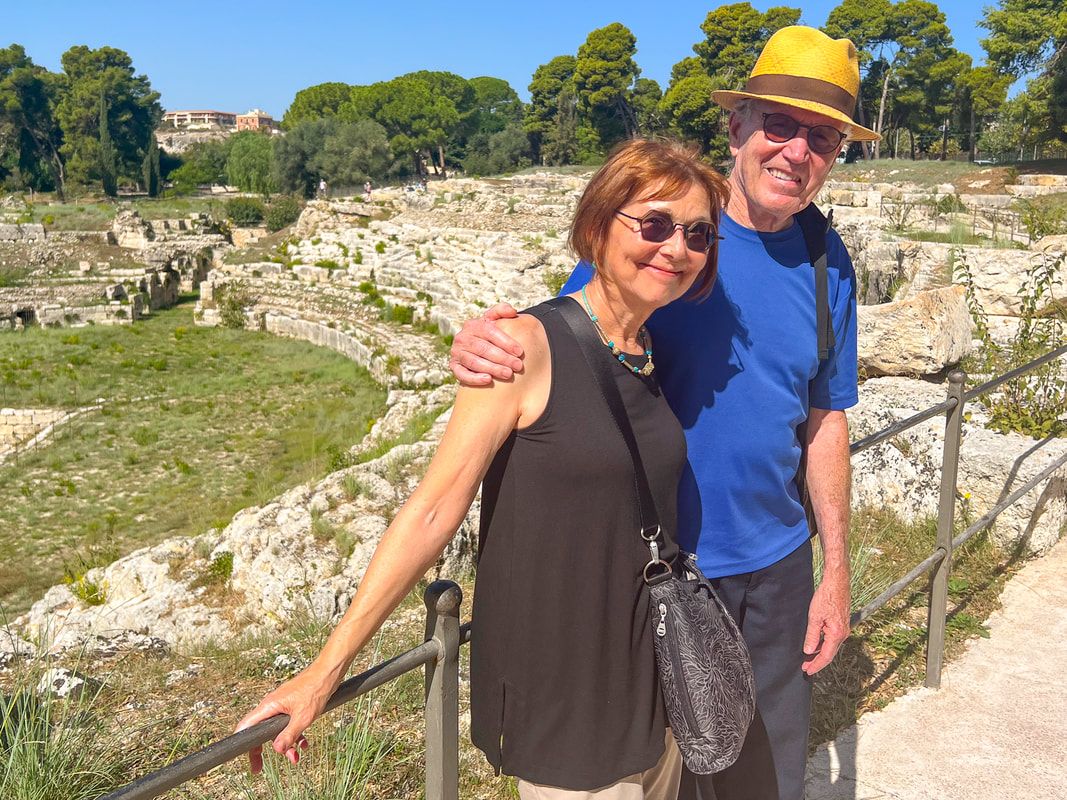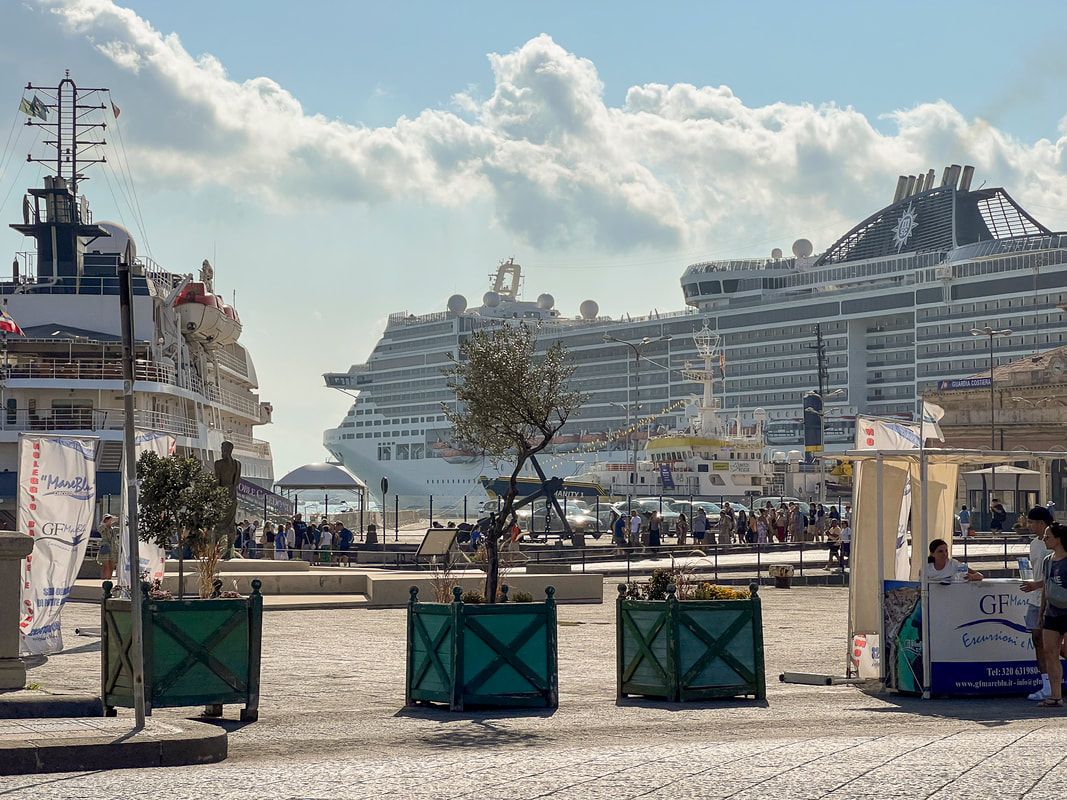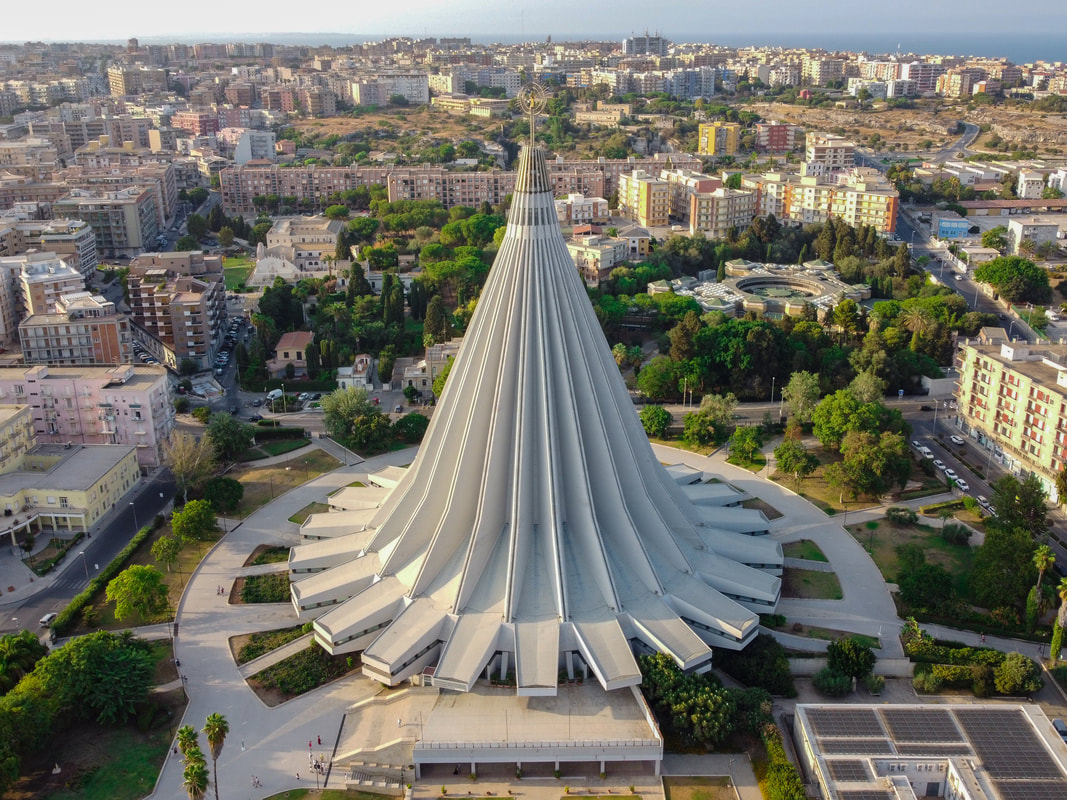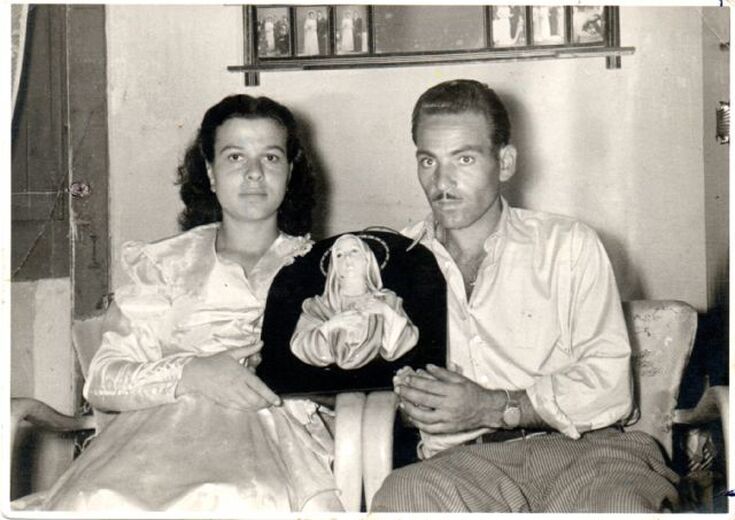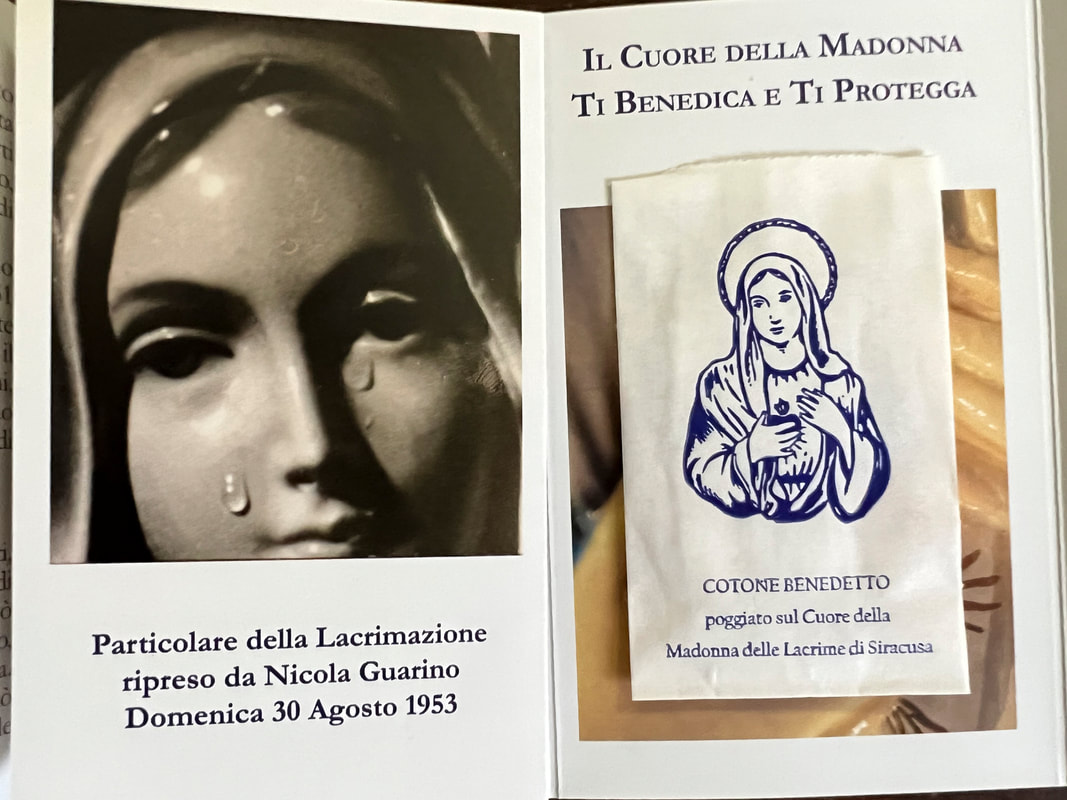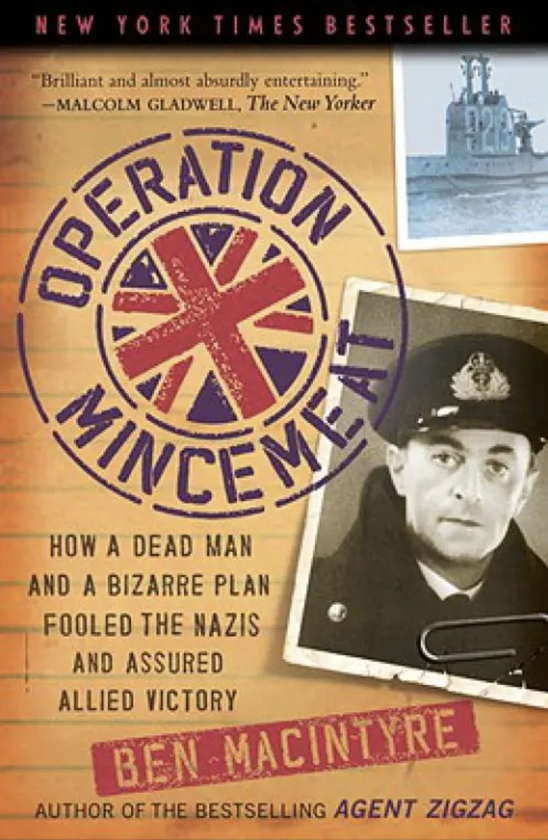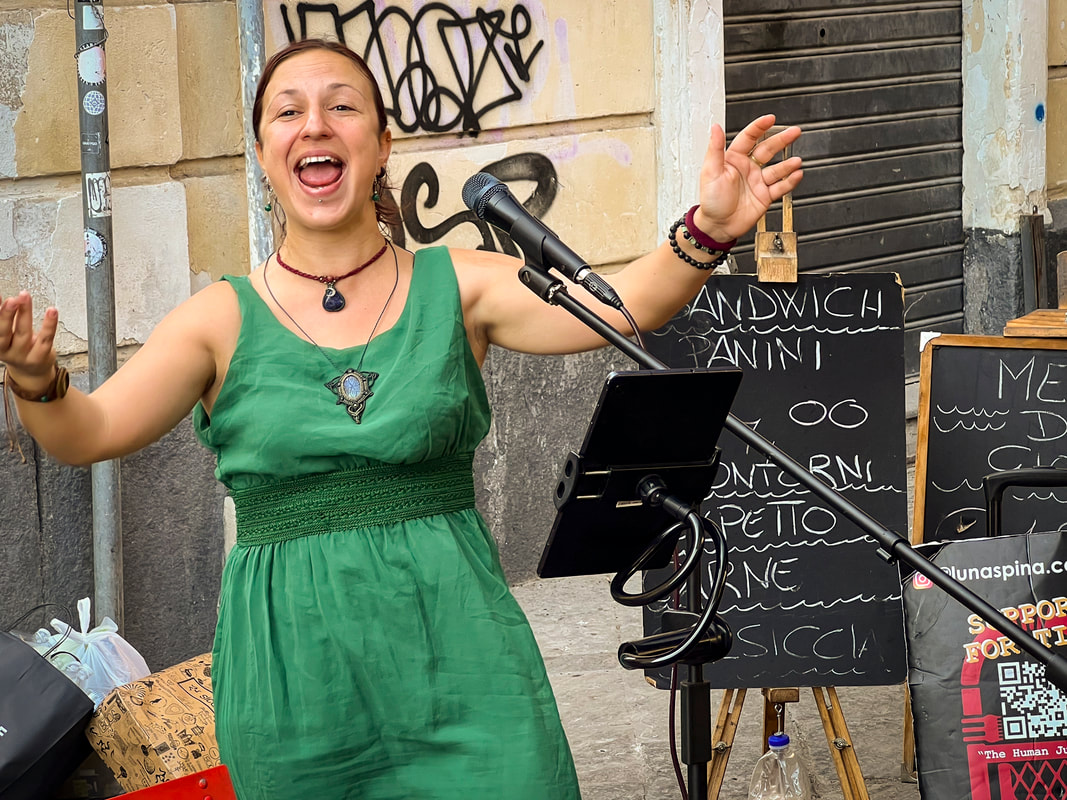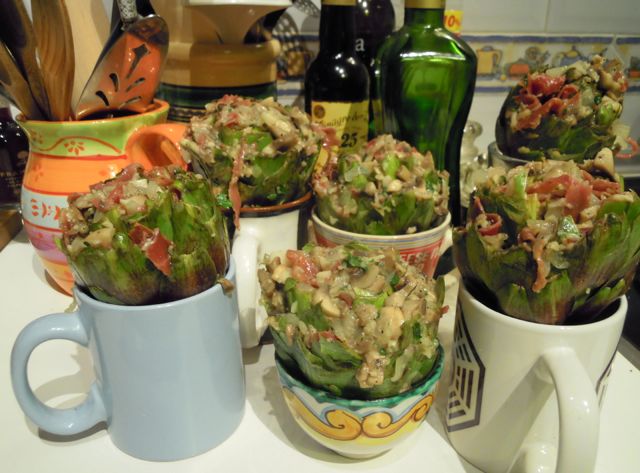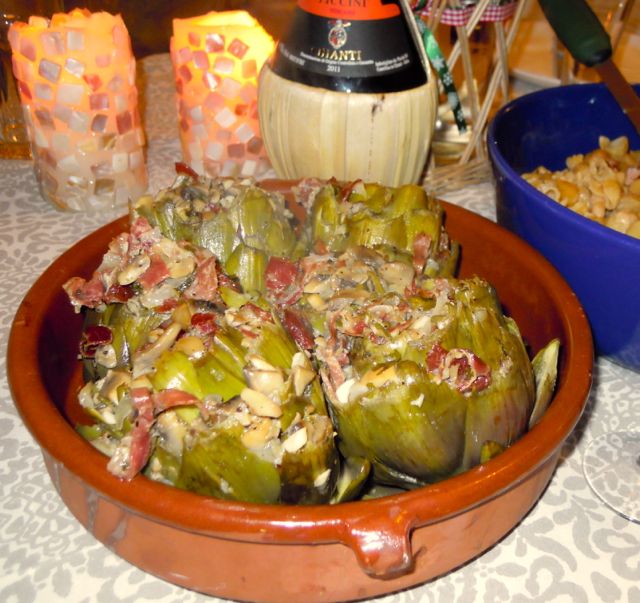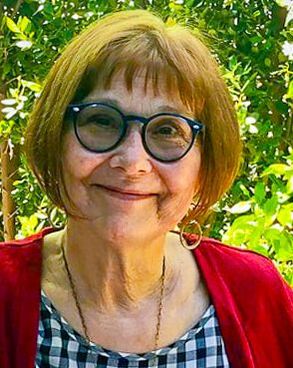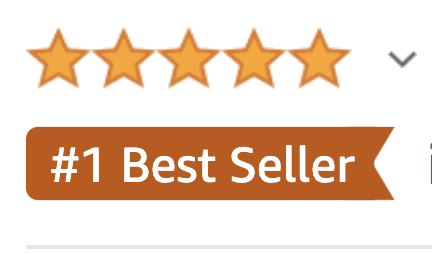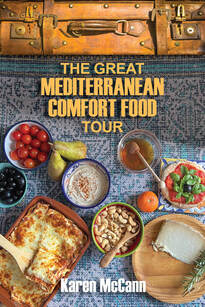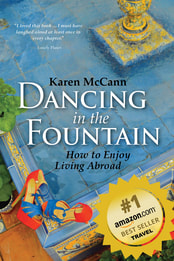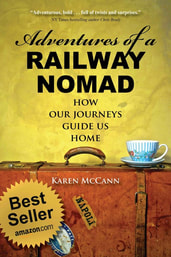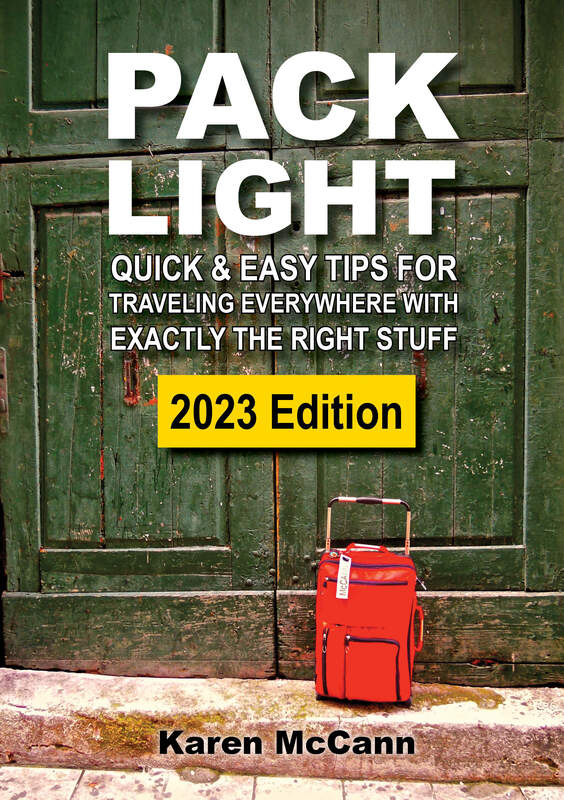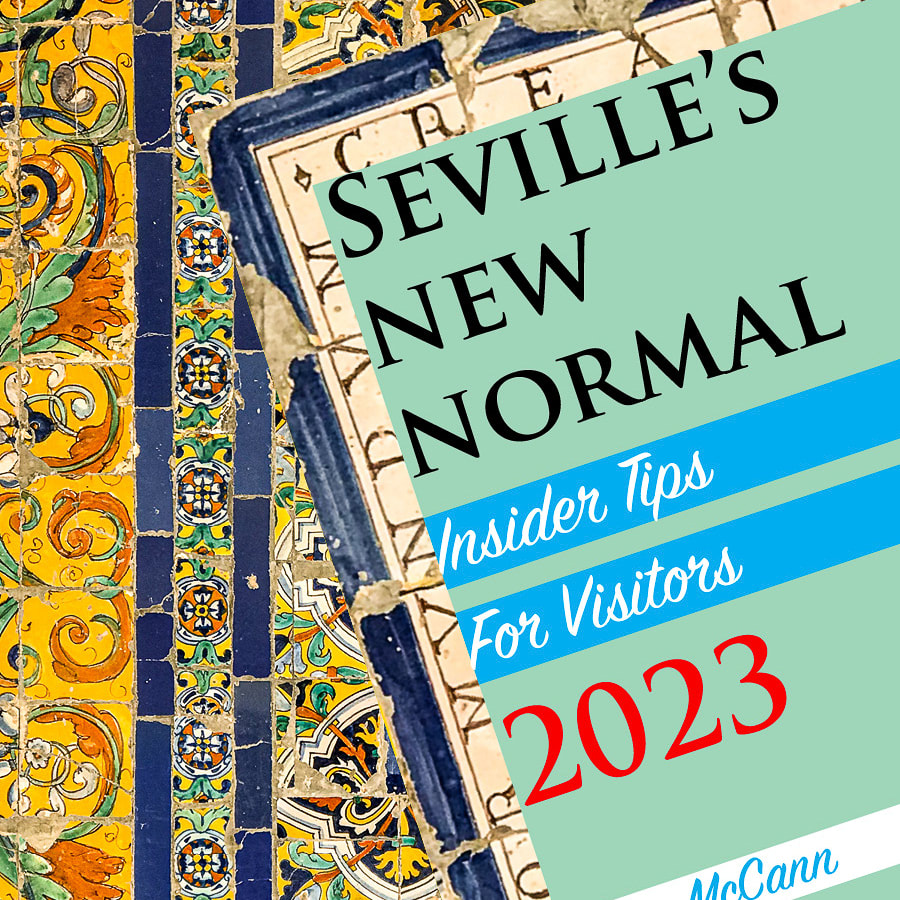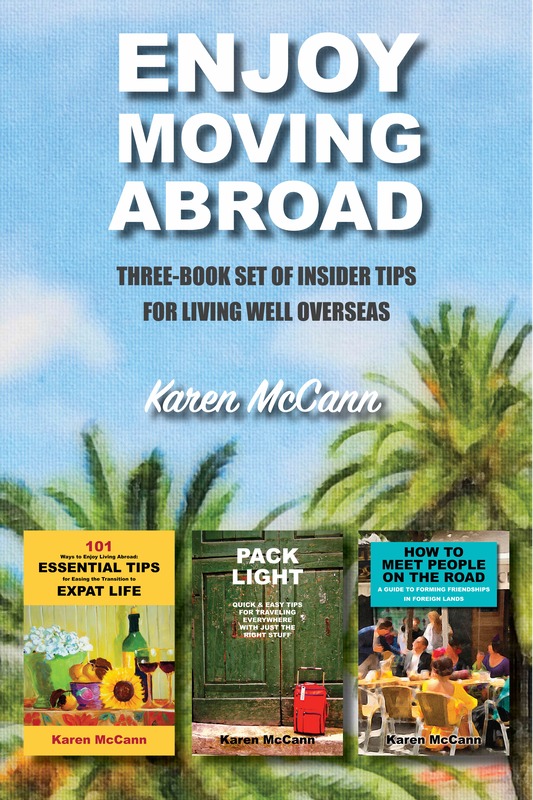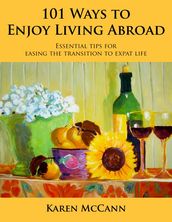|
“Let’s get out of here,” I yelled as the jackhammers started thundering overhead. Again. Rich pantomimed agreement and we shot out the door. We were staying in an otherwise delightful Airbnb in Syracuse, Sicily. It was sheer bad luck the neighbors directly above had chosen that week to smash up their old stone floors and tear out walls. Yes, of course we complained to our landlady, who explained it was nothing to do with her. Crashing masonry, pounding sledgehammers, and buzzing power tools resounded from early morning until late afternoon, occasionally rising to thunderous roars that rattled our light fixtures and made me wonder if they’d brought in elephants to do the heavy lifting. On the upside, we had plenty of motivation to start early and spend all the daylight hours exploring Syracuse. Like most visitors, we began at the city’s southern tip, on the island of Ortygia, where winding streets, ancient stone houses, and quaint tavernas create a sense of seamless storybook charm. But our luck was out in Ortygia too; our first day coincided with the arrival of a massive cruise ship, and the island was overrun with merrymakers. So Rich and I skedaddled north to check out the sprawling archeological site with its Greek and Roman ruins. You can’t tell the story of Syracuse without talking about the ill-fated, ill-considered, astonishingly boneheaded attack launched against it by Athens in 415 BC. By then Syracuse had become the dominant economic and military power in their corner of the Mediterranean, which annoyed the Athenians so much they decided it was time to give Syracuse its comeuppance. Normally the Athenians would have sent a modest force for this kind of job, but infighting among political factions resulted in radical and illogical choices. (Oh, those goofy ancients! How lucky we are not to have that sort of irrational decision-making today!) Athens committed nearly their entire fleet and 30,000 men, then put three ideologically opposed leaders in charge (because that always works out well). Syracuse was stunned by the massive attack, but luckily their ally Sparta sent one of their most kick-ass generals (not that Sparta had any other kind) to sort things out. Eventually he trapped the Athenian fleet in the harbor, enabling Syracuse to sink the invaders’ ships and capture the survivors. Most were sold as slaves, but 7000 prisoners of war were sent to work and live under horrific conditions in Syracuse’s stone quarry. Athens was depleted and demoralized, their enemies were emboldened, and the region’s balance of power shifted forever. Other than that, the plan worked perfectly. On the way to the archaeological site, I noticed an ultramodern building that looked like an upside-down ice cream cone. What fresh nuttiness was this? I soon learned the shape was meant to represent a teardrop, as this was the Basilica of the Madonna delle Lacrime (Our Lady of the Tears), built to house the city’s miraculous weeping statue. It all started in 1953, when a relative gave a modest plaster Virgin to newlyweds Antonina and Angelo Lannuso. Soon the bride became pregnant, and preeclampsia caused her to suffer convulsions and temporary blindness. Late one night she woke up, realized her sight had been restored, and saw Mary’s plaster face weeping. Antonina called in family members, who at first assumed she was hallucinating but then agreed the statue really was crying. (Watch videos of the Madonna weeping here.) As you can imagine, the town went wild. Scientists confirmed the liquid was consistent with the composition of human tears. The pope declared the event “real.” Antonina’s baby was born healthy — on December 25. It was all heady stuff. The statue has long since stopped weeping but is still on display in the ice cream cone — sorry, tear-shaped basilica. People used to catch the statue’s tears in handkerchiefs and treat them as relics, but now they just have priests bless bits of cotton which are tucked into holy cards and sold. Oh yes, I bought one and it’s been in my purse ever since. Not that I believe in asking for miracles, of course, because I am a modern and skeptical woman. But let me just tell you about the rich experiences that have occurred since I started carrying around the blessed cotton. For a start, we left that apartment in Syracuse, returning to Catania. What a relief to my eardrums! I visited Catania’s Museo Storico dello Sbarco in Sicilia 1943 (Museum of the 1943 Sicily Landing), which proved surprisingly interesting and deeply moving. If you paid attention in high school or know the book and/or movie Operation Mincemeat, you’ll appreciate how crucial the Allied invasion of Sicily was to winning the war. It succeeded in large part because the British convinced Hitler the invasion was happening in Greece, an elaborate deception involving a dead tramp dressed as an officer, fake papers, and a lot of nail-biting, cliff-hanging suspense. What I hadn’t really considered properly was how it must have felt to be in Sicily — especially Catania, which was bombed 87 times — during the six-week invasion. The tour gives you a dramatic glimpse of the experience. First you mill around in a model of a Catania square. Suddenly the air raid siren sounds and docents rush you into the bomb shelter. Sitting in near darkness with strangers, you hear planes approaching then bombs exploding, closer and closer. The shelter begins to shake, a little at first, then harder until your teeth are rattling. It’s highly effective and deeply disturbing, especially because I couldn’t stop thinking of all the people in Israel, Gaza, Ukraine, and elsewhere who are experiencing this very same thing right now for real. Catania offers visitors a rich array of experiences, including a vast, sprawling street market in the Piazza Carlo Alberto. One day Rich and I lunched there at a café then picked up supplies including a two-liter bottle of wine for 3 euros or $3.16. (It was a lot more drinkable than you might think.) (Yes, it was!) As we strolled homeward past fishmongers and piles of glistening vegetables, stall owners were packing up for the day, chatting and whistling. A woman with a microphone began singing the lead-in to a song. Wait, I knew this one, it was … “Volare,” she belted out. “Oh, oh…” And then, to my astonishment, the entire marketplace joined in. The young guy selling swordfish, the old lady buying tomatoes, the people sitting over lunch in the café, the delivery guys pushing carts — everyone suddenly burst into song, laughing and grinning at each other in sheer delight. Yes, of course Rich and I joined in. It was magical. Afterwards Rich kept muttering, “I can’t get that song out of my head.” “Don’t fight it,” I said. “We’ve gone nearly forty years without something we considered ‘our song.’ I think this is may be it. OK, I agree, 'Volare' is kind of an earworm and could get annoying. But look at it this way: at least it’s better than listening to the jackhammers in that Syracuse apartment.” “Amen to that.” AND THAT, MY FRIENDS, MARKS THE FINAL CHAPTER OF NUTTERS' TOUR OF SICILY 2023. YEP, WE'RE HEADING BACK TO SPAIN TOMORROW. Thanks for joining me on this long, zany journey. It’s been a hell of a ride. I won't post for a week or two while I catch my breath and settle back into my life in Seville. But don't worry, there are lots more looney adventures, travel tips, and mouthwatering culinary experiences coming up. I’ll keep you posted! In the meantime, feel free to browse through my previous posts about THE NUTTERS' WORLD TOUR WANT TO STAY IN THE LOOP? If you haven't already, take a moment to subscribe so you'll receive notices when I publish my weekly posts. Just send me an email and I'll take it from there. [email protected] And check out my best selling travel memoirs & guide books here. PLANNING A TRIP? Enter any destination or topic, such as packing light or road food, in the search box below. If I've written about it, you'll find it.
15 Comments
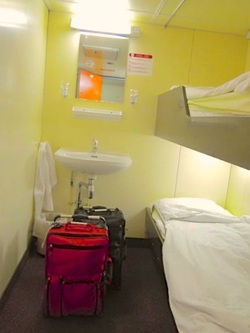 Our cabin on the Dubrovnik-Bari ferry Our cabin on the Dubrovnik-Bari ferry It was a dark and stormy night on the Adriatic. “’The sea was angry that day, my friends,’” said Rich, quoting the Seinfeld episode where George plays a marine biologist. “’Like an old man trying to send back soup in a deli.’” We were reeling about the pitching ferry, trying to find our mini-cabin in its lower depths. “You do realize,” he added, “that we’re actually below the cars and cargo? We’re in steerage.” We were sleeping in a six- by twelve-foot closet with two stacked bunks, a sink the size of a salad bowl, and nothing else. Well, sleeping is a bit of an exaggeration; we spent the night there, dozing fitfully, praying the tiny railings would hold and we wouldn’t go hurtling to the floor. Around two in the morning, when a trip to the bathrooms became necessary, we lurched through a series of heaving corridors, stumbling and crashing into walls, hoping we wouldn’t be flung bodily through anyone’s door. It was like trying to walk on the back of a bucking bronco, but with handrails. "Imagine weeks of this on the Atlantic,” I gasped. “Now I know why my grandmother vowed she’d never cross the ocean again,” said Rich. 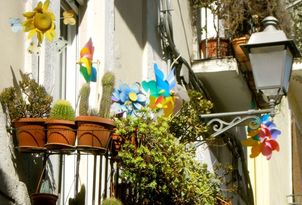 Pinwheels in Bari's old town Pinwheels in Bari's old town We were on deck at dawn, thrilled to see solid land on the horizon, even the unlovely harbor of Bari, which had clearly chosen the profits of shipping and petrochemicals over quaintness and charm. Leaving the cranes and silos behind and heading into the old quarter, we seemed to be the only non-locals about, which suited us just fine. On that bright, windy morning following the storm, every balcony was aflutter with sheets and flapping clothes, occasionally pinwheels as well. Doors stood wide open, and we saw cobblers tapping on boot heels, tailors stitching, women gossiping as their fingers shaped the little ears of pasta known as orecchiette, which they spread on mesh trays to dry in the midday sun. 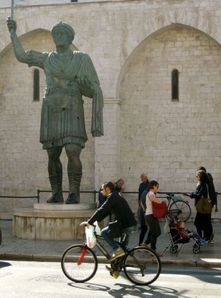 The Colossus of Barletta, Italy The Colossus of Barletta, Italy Our next port of call was Barletta, another town where industrialization helps keep the tourist hordes at bay. We wanted to pay homage to the town’s most famous resident, The Colossus, an ancient bronze statue standing 5 meters (16 feet) tall. No one is quite sure who he was – a fifth-century Roman emperor maybe? – or how he got to Barletta – washed up on shore after the sack of Constantinople perhaps? But everyone agrees he’s the guy who saved the city. According to ancient legend, when the Saracens were about to invade, The Colossus went down to the harbor and stood on the shore, weeping. “Why are you crying?” the Saracens asked. “Because I am so much smaller and weaker than everyone else in this city,” he moaned. Terrified at the prospect of fighting an army of giants, the Saracens rowed back to their ships with all due haste and left Barletta in peace. And I am sure every word of that story is true... 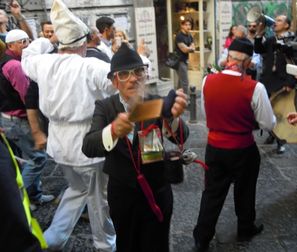 Just another surreal moment on the streets of Napoli Just another surreal moment on the streets of Napoli En route to our last stop, Pompeii, we decided to visit Naples, mainly because so many people had warned us against it. And it turned out to be everything we’d heard: dirty, noisy, crowded, chaotic. As our taxi roared down the wrong side of the street along the trolley tracks, honking at anyone who stopped at a red light, we saw a city as vibrant as the back streets of Asia, as zany as a street market in Mexico, and as quirky as San Francisco’s Height-Asbury during the summer of love (but as it turned out, with much better food). Within five minutes we had abandoned all thought of going to Pompeii and spent the next few days absorbing the madcap atmosphere of a city that refuses to conform to anyone else’s standards or expectations. Then it was time for an overnight ferry (smooth as glass! in our own stateroom!) to Barcelona and a high-speed train to Seville. I’m still getting over my train lag; I keep having urges to head to the station and board a train for somewhere. But mostly I’m simply delighted to be home, sifting through memories of the trip, and mulling over all the stories and travel tips I’ll be sharing with you in the months ahead. Yes, I've got lots more photos of Southern Italy. And for more about the journey – planning, packing, things we've learned, how many miles we traveled, etc. – see Train Trip/Central & Eastern Europe.  I don’t know about you, but my earliest impressions of Italian culture were based on the famous spaghetti scene in Lady and the Tramp. You know, the one where Tramp’s friend Tony sets up a table in the alley, the two dogs eat pasta under the stars, and Tramp pushes the last meatball over to Lady with his nose. When I was five, this seemed the height of romance to me. A few nights ago, I found myself sitting at a table in an alley in Genova, Italy, eating pasta under the stars with Rich, and for a delightful moment, I felt that real life and this favorite movie memory were merging in perfect harmony. I was only sorry I hadn’t ordered meatballs, so I could push the last one over to Rich with my nose. (Rich has expressed tremendous gratitude that I didn’t attempt this, especially in public.) 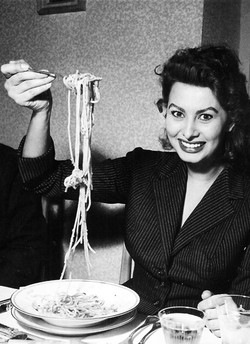 Sophia Loren is a big fan of spaghetti Sophia Loren is a big fan of spaghetti It’s no secret that we all carry around movie memories that deeply affect how we view the world. As we sat in that alley in Genova, drinking cheap wine on a sultry, moonlit night, Rich and I started talking about all the celluloid scenes that make up our images of Italian culture: The Godfather, Romeo and Juliet, Under the Tuscan Sun, La Dolce Vita, A Room with a View, Tea with Mussolini, The Italian Job, The Bourne Identity, Moonstruck, the Agony and the Ecstasy, Sophia Loren love triangles, Fellini’s surrealist fantasies, the lives of the saints the nuns showed us at school, and countless others. And out of a lifetime of movie memories, we choose the ones that strike a particular chord in us. For some, Italy is all about the high life in the Riviera; for others it might be art, or religion, or political power, or the warmth of being part of a family (even if it’s the kind of Family that makes you offers you can’t refuse). And if we’re lucky, when we travel, we have moments that strike that chord in a deeply agreeable way. 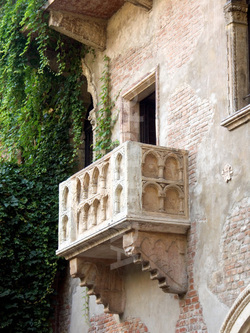 "Juliet's balcony," added in 1936 "Juliet's balcony," added in 1936 “People say that what we’re all seeking is a meaning for life,” Joseph Campbell wrote in The Power of Myth. “I don’t think that’s what we’re really seeking. I think that what we’re seeking is an experience of being alive, so that our life experiences on the purely physical plane will have resonances with our own innermost being and reality, so that we actually feel the rapture of being alive.” As I write this, I am in Verona, which (as the town is very quick to remind you at every turn) was the setting for Shakespeare’s Romeo and Juliet. Today, we’ll probably see the famous “Juliet’s balcony.” Of course, this is no more Juliet’s real balcony than 221B Baker Street in London is the real home of Sherlock Homes because – and I think you can follow my logic here – they are both fictional characters. But thousands of people visit these places every year to have an experience that lets them connect their inner and outer lives in a way that sparks the rapture Joseph Campbell is talking about. 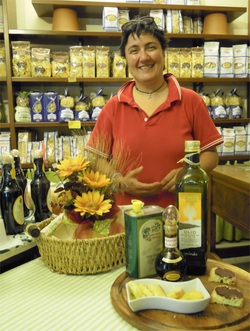 Francesca in le Gramole, Genoa Francesca in le Gramole, Genoa Part of the way I connect with Italy is, of course, the food. (Think of Clemenza, teaching young Michael Corleone how to make spaghetti sauce when the men “go to the mattresses.” Think of the pasta scene in Eat, Pray, Love. Need I go on?) The day after our Lady-and-the-Tramp dinner, Rich and I went to an olive oil tasting at a tiny, back street olioteca. Having lived nearly ten years in Seville, we were able to hold our own in a lively discussion of the rival merits of regional varieties, and pretty soon our hostess, Francesca, was fetching stools so we could sit for a more leisurely sampling, bringing out more kinds of olive oil she wanted us to try, and finally, with the air of one bestowing a magnificent treat, running to get her special, 25-year-old vinegar so she could drizzle it over slivers of Parmesan cheese. The flavors were wonderful, but the real pleasure was sharing them with someone who took such obvious delight in savoring life’s essentials. Over the years and many miles we’ve traveled together, Rich and I have learned that the moments that really resonate with us are far more likely to come in little, back-street food shops and shabby trattorias than in five-star restaurants. These are the moments that make us who we are. As Sophia Loren once put it, “Everything you see I owe to spaghetti.” Or in the words of Federico Fellini, “Life is a combination of magic and pasta.” Next summer, Rich and I will walk out our door in Seville, stroll to the train station with our rolling luggage, and board a train to begin a journey that will last several months and cover thousands of miles. We won't have any reservations anywhere, just a Eurail pass and an iPad full of information about possible destinations. We'll wend our way by easy stages through Central and Eastern Europe, winding up in Transylvania and some of the more obscure Balkan countries, seeking offbeat side trips and weird, wonderful stories and adventures. We hope to connect up with locals and expats all along the way. If you know someone in one of our destination areas – even better, if you ARE someone in one of our destination areas – send us an email and we'll see about meeting up. I'll post a map when we've firmed up the general route. We have decided to begin by taking the train to Barcelona, then the ferry across to Genoa, Italy. And here's what I've learned about that destination city... Nearly every Genoa tourism website starts off by pleading, “Please don’t rush through here on your way to Florence or Rome. No matter what you’ve heard about us, we really are worth a visit! Really! Please say you'll stay!!!” OK, I’m paraphrasing a little, but that’s the gist. Apparently Genoa is the Newark of Italy, a place most people arrive in only to depart as quickly as possible for more glamorous destinations. 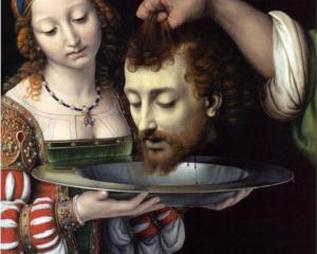 So what does Genoa have to offer? It's a gorgeous old city with lots of historic buildings and museums, promoted with such awkwardly translated prose as: “Thought then to the birthplace, even though few of them remembered their location, so that at first it was a walled marble plaque in memory above the entrance of a building facing.” Hard to understand how that could fail to entice tourists... Struggling through the prose, I discovered some real (or possibly fake) gems. For instance, the Museum of the Cathedral of San Lorenzo houses the actual platter on which Salome placed the head of John the Baptist after his decapitation. Now THAT’S something worth seeing! Naysayers may question its authenticity, but I for one am ready to believe. The museum also contains the Ark of the Ashes of John the Baptist, a splinter of the True Cross, and a chalice that was believed to be the Holy Grail when it was brought back from the Holy Land by a crusader. It’s easy to scoff at such ignorance today, now that we all know the Holy Grail was actually found by Indiana Jones. While some of its ancient relics may be suspect, Genoa does boast a genuine haunted house. Now known as the Ca ‘de Anime (House of Spirits), back in the 18th century it was an inn situated on a lonely road outside of town. 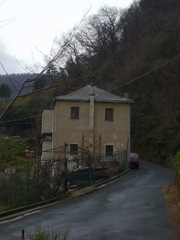 The genial hosts were a family of robbers who killed their richer guests, relieved them of their possessions and buried the bodies nearby. The mysterious disappearances of so many of the inn’s patrons gave rise to rumors that the inn was haunted, but investigators later exposed the guilt of the robber family and executed them all on the spot. That's when the real haunting began... The inn remained vacant until a desperate family moved in during World War II. The new occupants managed to ignore mysterious sounds and inexplicable broken objects around the house, but when a strange girl seemed to materialize out of the 18th century, they fled the house never to return. Rich and I will be reviewing The Exorcist and Poltergeist in preparation for the visit. But what about modern Genoan life? The region is famous for its salami and pesto, but what other pleasures could we expect at the Genoan table? I discovered Giada De Laurentiis' wonderful recipes for two regional favorites, Orichiette with Sausage, Beans and Marsarpone and Genovese-style Artichokes. The orichiette (pasta shaped like little ears) was delicious, but the true hit of the evening was the artichoke dish. We stuffed the artichokes with a mixture of garlic, onion, ham (we substituted good Spanish jamon for the prosciutto), Parmesan cheese and parsley. Then we put them in a deep pot, wedged together to say upright in a pool of white wine, and let them simmer 45 minutes on the stovetop until they were tender and had soaked up the wine flavor. Rich and I decided that Genoa may have its issues with public relations, artifact authentication and online translation programs, but when it comes to the pleasures of the table, it’s a city second to none. Looking forward to making your acquaintance, Genoa!
If you know someone living in Genoa – even better, if you are living in Genoa yourself – send us an email and we'll see about meeting up. We're looking for insider information about the city and its quirkier aspects. First round of drinks is on us. This is a guest post by Chris Brady, the NY Times bestselling author of A Month of Italy: Rediscovering the Art of Vacation and several other titles. You may also remember Chris as the man who penned the lovely words, "McCann's writing is warm, inviting, immediately charming, and constantly entertaining. Her narrative was so good I found myself wanting to hear more about Cleveland! Now THAT's good travel writing!" Obviously a man of discerning taste. Chris and I thought it would be fun to exchange blogs, so I invite you to sit back and enjoy his piece here, and then to visit his site and read my blog, The Joy of Eating. Happy reading! 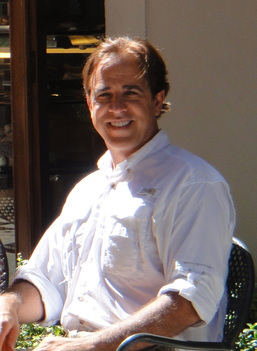 “I looked at the people and buildings of Montalcino with eloper’s eyes, knowing what they didn’t: I was about to take flight and leave them behind. A couple of days of hassle and I would be dropped back into my previous life like an apparition. The razor blades providing death to the artist by a thousand cuts of emails, texts, faxes, voice mails, ringing phones, commitments, meetings, and deadlines were about to be given their chance at revenge. They wouldn’t care what we had seen, what we had felt, how our time away had changed us. They wouldn’t feel the metamorphosis that had taken place deep inside. I knew I was entering a transformation as necessary as the digitizing of a document to enable faxing. First I had to withdraw ... next came the dread of returning to the violence of the normal. Finally would come the yearning for the familiar and the needed awakening from the dream...” This excerpt from my book, A Month of Italy: Rediscovering the Art of Vacation, attempts to deal with the inevitable emotional transitions we travelers are forced to confront as we translate our bodies from one location to another. Something in us resists the change of scenery and lingers behind, especially if the time spent was particularly moving and meaningful. 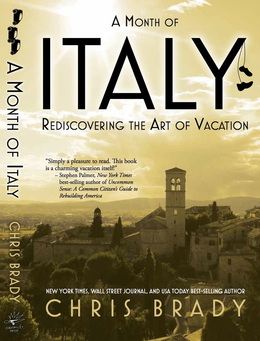 Karen McCann deals with this in her fantastic book, Dancing in the Fountain: How to Enjoy Living Abroad. "Finally, during my third summer in San Anselmo, it occurred to me that I was fixated on viewing California not as it was, but through the lens of my life in Spain. While the rest of me was arriving in San Anselmo, I’d left my head and heart back in Seville. I was not mentally unpacking my bags. Despite living just a short distance from the communities in which I grew up, went to college, got married, and had family all over the place, I felt more like a foreigner than I did in Spain — or Cleveland, or Boston, or any of the other places I’d lived." If you’ve ever spent meaningful and significant amounts of time “elsewhere,” you know exactly what Karen is describing. There is a power of place that gets inside us like the smell of spices in clothing and can’t readily be removed just because we’ve carted ourselves to a different location. As Karen says, we must “mentally unpack our bags.” I would suggest the following possible steps to take to help you accomplish this “mental unpacking:” 1. Think of people first. By far, the easiest way to transition to the next place is to put yourself in mind of the people with whom you’ll be able to once again spend time. Perhaps there are old relationships that can be rekindled or new ones to be built. 2. Anticipate adventure. Next, it is helpful to focus on new milestones and experiences to be sought in the next phase of your existence. These things can only take place if you are “there,” so be glad that you are! 3. Muster courage. There is something inside each of us that longs for everything to stay exactly the same forever. This cannot be. We must face this reality with courage and push ourselves through to the next phase. It is only on the other side of trepidation that exhilaration exists. 4. Cultivate memories. Leaving a place behind doesn’t mean losing it. Memorialize your time in each place with photos, journals, and memories so that much of what is gained can be captured, preserved, and repeatedly enjoyed. 5. Promise to return. It’s a bit of a sleight of hand to leave a place emotionally by promising to return, but I’ve found this to work extremely well. And don’t worry about that old traveler’s fable that says never to return to a beloved place because it will never be as good the second time. This is patently false. All of this, perhaps, can be summed up in one phrase: be where you are. In other words, wherever you go, make sure you are there. In the Preface to her book, Karen handles this nicely. "But as it happened, I loved Cleveland (yes, I did!). I had moved around a lot over the years, propelled by fluctuations in the family fortunes and later my own, and I had learned that I could make a good life for myself practically anywhere. One thing I know to be true: the secret is mentally unpacking your bags. Or, as the Buddhists like to put it, being here now." May you travel widely, experience deeply, and manage to be where you are wherever you go. Chris Brady is the NY Times bestselling author of A Month of Italy: Rediscovering the Art of Vacation and several other titles. Listed as the world’s #11 Leadership Guru, he was voted one of the Top 100 Authors to Follow on Twitter. Chris also writes an eclectic blog on the general theme of “living a life that matters.” Incidentally, Chris is also an avid motorized adventurer, world traveler, humorist, community builder, business owner, soccer fan, and dad. He has one of the world’s most unique resumes, including experience with a live bug in his ear, walking through a paned-glass window, chickening out from the high dive in elementary school, destroying the class ant farm in third grade, losing a spelling bee on the word “use,” jack-hammering his foot, and, more recently, sinking his snowmobile in a lake. Chris and his wife Terri have four children and live in North Carolina. |
This blog is a promotion-free zone.
As my regular readers know, I never get free or discounted goods or services for mentioning anything on this blog (or anywhere else). I only write about things I find interesting and/or useful. I'm an American travel writer living in California and Seville, Spain. I travel the world seeking eccentric people, quirky places, and outrageously delicious food so I can have the fun of writing about them here.
My current project is OUT TO LUNCH IN SAN FRANCISCO. Don't miss out! SIGN UP HERE to be notified when I publish new posts. Planning a trip?
Use the search box below to find out about other places I've written about. Winner of the 2023 Firebird Book Award for Travel
#1 Amazon Bestseller in Tourist Destinations, Travel Tips, Gastronomy Essays, and Senior Travel
BLOG ARCHIVES
July 2024
CATEGORIES
All
|
